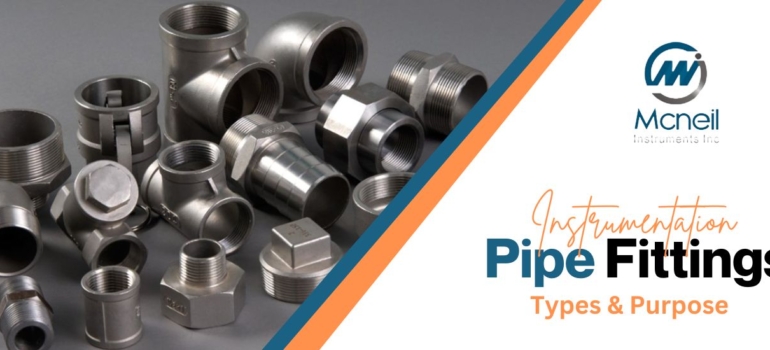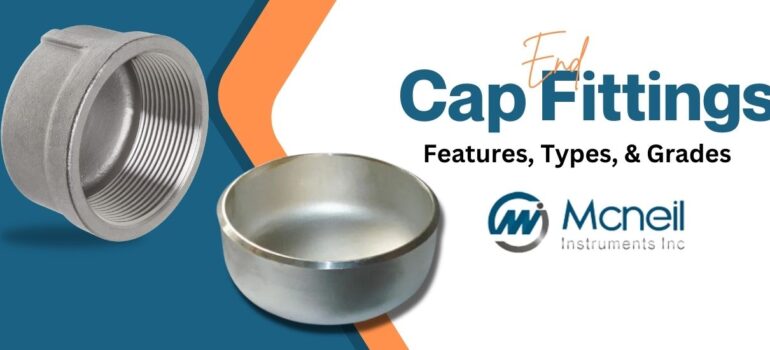Pipe Fittings in Plumbing Systems
Pipe fittings are used in plumbing systems as connectors to join various pipe or tube pieces. They are essential for regulating the flow of fluids like gas and water since they can take on a variety of forms and sizes. Located in both residential and commercial buildings, these fixtures are necessary for controlling gas flow, handling waste, and supplying water. More complicated plumbing systems are made possible by their ability to expand, change sizes, and travel greater distances. Fittings must be flexible to build effective networks and guarantee that plumbing systems operate properly in a variety of settings.
Types of Pipe Fittings & their Purpose
Pipe fittings, sometimes referred to as pipe connectors, join two pipes in a plumbing system to extend the run or reverse the direction of flow. Pipe fittings, such as elbows and tees, are a type of piping component that aids in altering the flow’s direction. modifies pipe sizes, such as reducing tees and reducers. Attach various parts, like couplings, and halt flows, like caps. They come in a range of sizes to fit the pipe they will connect, and they are used to combine, divert, or reduce the flow of the water supply.
Types of Pipe Fittings
When it comes to plumbing, there are Various kinds of pipe fittings. The list of pipe fittings used in plumbing work and Industrial use is below:
- Coupling Pipe Fitting
- Plug & Union Pipe Fitting
- End Cap Pipe Fitting
- Female Branch Tee Pipe Fitting
- Female Elbow Pipe Fitting
- Male Run Tee Pipe Fitting
- Female Run Tee Pipe Fitting
Coupling Pipe Fittings:
A pipe coupling is used to permanently join two pipes by sliding them over one another exteriors. A coupling that joins a larger pipe to a smaller size can be referred to as a reducer, or reducing coupling. This reduces flow. When joining two different types of pipes, couplings are used.
Plug & Union Pipe Fitting:
Plug and Union are similar to caps in that they are used at the end of a pipe to seal the opening. The distinction is that while caps fit over the opening, plugs fit into threaded pipe openings to create seals. They are frequently discovered at sewage system clean-out sites.
End Cap Pipe Fitting:
End cap pipe fittings are similar to caps in that they are used at the end of a pipe to seal the opening. A hat To stop the flow of gas or water, pipe fittings are placed over the end of the pipe. These fittings can be used to temporarily cut off the supply during a plumbing project or as the permanent termination point for a pipe.
Female Branch Tee Pipe Fitting:
Female branch tees are another widely used kind of pipe fitting. The female branch tee connects fractional tubes to male NPT threads, whereas the male branch tee connects to a female NPT thread. This is the primary distinction between the male and female branch tees. These fittings are widely used in many different industries and are available in inch and metric tube sizes.
Female Elbow Pipe Fitting:
female elbows A common type of pipe fitting is one that allows a pipe run to change direction at an angle. Connecting a fractional tube to a female tapered pipe thread requires a male pipe elbow, but connecting a fractional tube to a male NPT thread requires a female elbow. These particular pipe fittings, such as female elbows, are intended for use with equipment used in pulp and paper, chemical, petroleum, electronic, and process facilities. They are also intended for use with instrumentation, process, and control systems.
Male Run Tee Pipe Fitting:
Male Run tees are Tee Connectors that have ferrule-type joints on the other two ends and male pipe threads on the run side of the tee joint. It is made up of seven expertly manufactured parts, including two body parts. Two back ferrules, two front ferrules, and two nuts. High-pressure leakproof tee joints are achieved in metal tubing by swaging ferrules on the outside diameter (OD) of the tubing at two angular ends and connecting the third end to a female threaded open port.
Female Run Tee Pipe Fitting:
Female Run Tees are a sort of pipe fitting that is typically used to join different fractional pipes. They are simple to assemble. The fractional link between the male NPT thread and these female tees is formed. These basically have three connection points, two of which go from the fittings left to right and the other which splits off. These fittings guarantee prompt branch connections. The fittings are made of a variety of materials, including rubber, carbon steel, plastic, and stainless steel.
Criteria for choosing pipe fittings:
When selecting pipe fittings, a few things need to be taken into account. They are listed in the following order:
Connectivity types: You should know that there are two possible connector types for pipe fittings when making your purchase. A female threading may be used on one end of the fitting and a male threading on the other. In the case of metal fittings, one end may be male slip and the other threaded. Additionally, they can have matching ends to meet any needs.
Construction materials: Generally speaking, the pipe fitting and the pipe it is intended to be installed in should be made of the same material. Materials that adhere to specific norms or codes, however, can occasionally be utilized in pipes made of different materials.
Verify the flow: The ends of pipe fittings should be somewhat larger than the pipe itself in order to allow for connections without causing the inner diameter (ID) of the pipe to narrow and compromise flow consistency.
Fitting type: In addition to the materials used for the pipe, pipe fittings can be distinguished by their threaded, slip, male, or female connections.
Size: It should be noted that when determining the size of pipe fittings, female fittings are measured to the inside edge of the inlet, or ID, while male threaded fittings are measured to the outside edge or OD.
Thickness: The pipe fittings come in a variety of thicknesses or “schedules,” just like the pipes.
Design: Every pipe or tube is made to transport a certain kind of liquid, gas, or chemical under a range of circumstances. As a result, a range of designs are also available for the pipe fittings.
Codes and standards: The various pipe fittings are graded according to standards and codes established by different organizations. Certain standards, including ASTM, ASME, BSP, and others, are applied to pipe fittings and specify how they must be used.
Pipe Fittings according to Uses:
Pipe fittings can be divided into the following categories based on the functions they serve:
| Fitting Purpose | Fitting Types |
| Pipe fittings for finishing off or extending lines of pipe | Couplings, Plug and Union, & end Caps |
| Fittings to reverse the direction of a pipe | Female Elbow |
| fittings for pipes that join two or more pipes | Female Branch Tee, Male run Tee, Female Run Tee, Cross Fittings |
| Pipe fittings to adjust the size of the pipe | Couplings, Bushings, Reducers |
| Pipe fittings for controlling or adjusting flow | Valve Fittings |
| Pipe Fitting Tools | Pipe Fasteners |
Conclusion
For any pipes and plumbing systems utilized in commercial and industrial applications, pipe fittings are in high demand. Pipes can be linked, installed, and terminated or closed as needed with the use of fittings. They are a crucial component of plumbing and pipe systems. Many thousands of specialty fittings are produced. Although each kind of pipe or tube needs a different kind of fitting, most pipe fittings have a few characteristics in common. Mcneil Instruments Inc. Is one of the best Pipe fittings Manufacturers, Suppliers, & Exporters
#pipefittings #couplingpipefitting #plugpipefitting #unionpipefitting #cappipefitting #feamlebranchteepipefitting #femaleelbowpipefitting #malerunteepipefitting #femalerunteepipefitting









